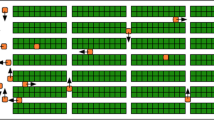Abstract
In this paper, an MILP formulation is proposed for the design of a reverse logistics network based on a warehouse location–allocation model, which optimizes, simultaneously, the forward and reverse networks. A single product model with unlimited capacity is first defined. Subsequently, the model is extended to a multi-product capacitated recovery network model, where capacity limitations and a multi-product system can be considered. The proposed model is compared to published work in the field, where different model assumptions have been proposed. Two cases are described so as to gain a better insight into the model and allow a comparative analysis.
Access this article
We’re sorry, something doesn't seem to be working properly.
Please try refreshing the page. If that doesn't work, please contact support so we can address the problem.









Similar content being viewed by others
References
Ammons JC, Realff MJ and Newton D (2000). Decision models for reverse production system design. In: Madu CN (eds) Handbook of Environmentally Conscious Manufacturing. Kluwer: Boston, pp 341–362.
Ayres RU, Ferrer G and van Leyneele T (1997). Eco-efficency, asset recovery and remanufacturing. EurMngt J 15 (5): 557–574.
Barros AI, Dekker R and Scholten V (1998). A two-level network for recycling sand: A case study. Eur J Opl Res 110: 199–214.
Bloemhof-Ruwaard JM, Salomon M and van Wassenhove LN (1996). The capacitated distribution and waste disposal problem. Eur J Opl Res 88: 490–503.
Brooke A, Kendrick D, Meeraus A and Raman R. (2003). GAMS: A User's Guide. GAMS Development Corporation: USA.
Fleischmann M, Beullens P, Bloemhof-Ruwaard JM and van Wassenhove LN (2001). The impact of product recovery on logistics network design. Prod Opl Mngt 10: 156–173.
Jayaraman V, Guide Jr VDR and Srivastava R (1999). A closed-loop logistics model for remanufacturing. J Opl Res 50: 497–508.
Jayaraman V, Patterson RA and Rolland E (2003). The design of reverse distribution networks: models and solution procedures. Eur J Opl Res 150: 128–149.
Lappalainen T, Pekari T and Vihavainen M (2002). Housing in European Cities: Statistical Comparisons [on-line]. Helsinki City Supplies Department: Helsinki, pp 6–8. www.hel.fi/tietokeskus/en/tilastoja/Housingvari.pdf accessed 23 January 2004.
Le Blanc HM, Fleuren HA and Krikke HR (2002). Redesign of a recycling system for LPG-tanks Centre Applied Research working paper no. 2002-01, The Netherlands.
Marín A and Pelegrin B (1998). The return plant location problem: modelling and resolution. Eur J Opl Res 104: 375–392.
Salema MI, Barbosa-Póvoa AP and Novais AQ (2005). An optimization model for the design of a capacitated multi-product reverse logistics network, with uncertainty. Eur J Opl Res (special issue on Advances in Location Analyses) (in press).
Thierry M, Salomon M, van Nunen J and van Wassenhove L (1995). Strategic issues in product recovery management. Calif Mngt Rev 37 (2): 114–135.
Author information
Authors and Affiliations
Corresponding author
Appendix: Performance enhancer
Appendix: Performance enhancer
Consider α p, α w and α r to be, respectively, the smallest integer number of factories, warehouses and of disassembly centres, at their largest capacity, that must be opened in order to satisfy all the demand and return. The lower bound constraints for factories, warehouses and disassembly centres are, respectively, given by constraints (A.1) (A.2) and (A.3).



The upper bound constraints introduced in DeM extended are defined as follows:




The β value was replaced by the lowest possible value that allowed a feasible upper bound constraint.
Rights and permissions
About this article
Cite this article
Salema, M., Póvoa, A. & Novais, A. A warehouse-based design model for reverse logistics. J Oper Res Soc 57, 615–629 (2006). https://doi.org/10.1057/palgrave.jors.2602035
Received:
Accepted:
Published:
Issue Date:
DOI: https://doi.org/10.1057/palgrave.jors.2602035



